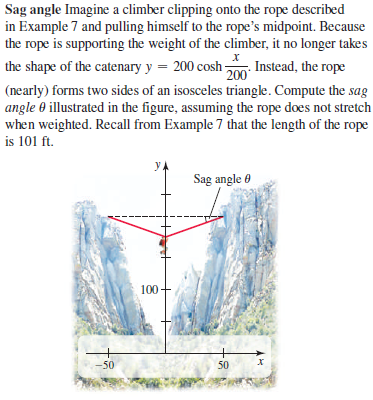Sag angle Imagine a climber clipping onto the rope described in Example 7 and pulling himself to the rope's midpoint. Because the rope is supporting the weight of the climber, it no longer takes the shape of the catenary y = 200 cosh m Instead, the rope 200 (nearly) forms two sides of an isosceles triangle. Compute the sag angle 0 illustrated in the figure, assuming the rope does not stretch when weighted. Recall from Example 7 that the length of the rope is 101 ft. y, Sag angle 0 100 -50 50
Sag angle Imagine a climber clipping onto the rope described in Example 7 and pulling himself to the rope's midpoint. Because the rope is supporting the weight of the climber, it no longer takes the shape of the catenary y = 200 cosh m Instead, the rope 200 (nearly) forms two sides of an isosceles triangle. Compute the sag angle 0 illustrated in the figure, assuming the rope does not stretch when weighted. Recall from Example 7 that the length of the rope is 101 ft. y, Sag angle 0 100 -50 50
Algebra & Trigonometry with Analytic Geometry
13th Edition
ISBN:9781133382119
Author:Swokowski
Publisher:Swokowski
Chapter6: The Trigonometric Functions
Section6.7: Applied Problems
Problem 53E
Related questions
Question

Transcribed Image Text:Sag angle Imagine a climber clipping onto the rope described
in Example 7 and pulling himself to the rope's midpoint. Because
the rope is supporting the weight of the climber, it no longer takes
the shape of the catenary y = 200 cosh m Instead, the rope
200
(nearly) forms two sides of an isosceles triangle. Compute the sag
angle 0 illustrated in the figure, assuming the rope does not stretch
when weighted. Recall from Example 7 that the length of the rope
is 101 ft.
y,
Sag angle 0
100
-50
50
Expert Solution
This question has been solved!
Explore an expertly crafted, step-by-step solution for a thorough understanding of key concepts.
This is a popular solution!
Trending now
This is a popular solution!
Step by step
Solved in 2 steps with 1 images

Recommended textbooks for you

Algebra & Trigonometry with Analytic Geometry
Algebra
ISBN:
9781133382119
Author:
Swokowski
Publisher:
Cengage

Trigonometry (MindTap Course List)
Trigonometry
ISBN:
9781337278461
Author:
Ron Larson
Publisher:
Cengage Learning

Algebra & Trigonometry with Analytic Geometry
Algebra
ISBN:
9781133382119
Author:
Swokowski
Publisher:
Cengage

Trigonometry (MindTap Course List)
Trigonometry
ISBN:
9781337278461
Author:
Ron Larson
Publisher:
Cengage Learning